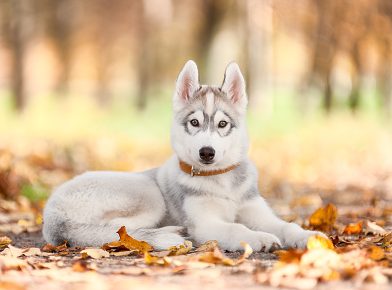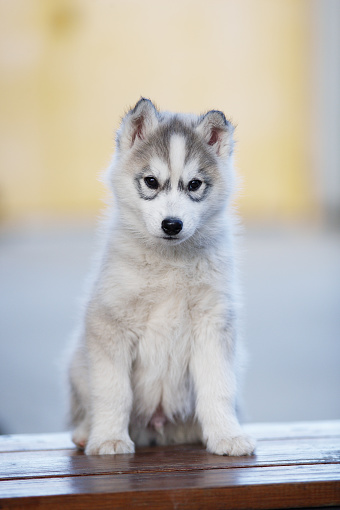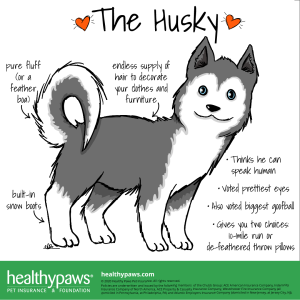Key Takeaways
- Siberian huskies are loving, affectionate, and energetic dogs.
- These dogs do best in larger homes and in mild or cool climates.
- The breed’s history dates back roughly 3,000 years.
- Common health issues of huskies are cataracts and corneal dystrophy.
- Huskies love to run, dig, and escape from confined spaces.
Table of Contents
With their beautiful thick coats and piercing eyes, the Siberian Husky is a truly exotic breed to behold. You probably are most familiar with their role as sled dogs, which demonstrates their perseverance, athleticism, loyalty, and, of course, affinity for cool climates. If you’re eager to discover more about this breed’s personality, historic background, and important medical information, check out the encompassing guide we’ve put together for you below.
Breed Personality and Physical Description
If we had to sum up the husky’s personality in one sentence, we’d tell you that they’re an incredibly loving and affectionate breed with impressive amounts of energy and a true desire to explore the world. They get along very well with children, strangers, and other large animals — one reason why they may not be the best guard dog — and they will love you forever if you take them out of the house every single day to play for hours at a time. (Heads up: huskies were bred to hunt small prey, so some don’t get along well with cat-sized animals or smaller.) Huskies are also known to be quite vocal with a loud bark.
For the above reasons, we recommend huskies for pet parents who are less about that Netflix and takeout life, and more about the “let’s see what we can explore outside today!” life. They also tend to do better in larger homes given their size, and it’s best that they live in mild or cool climates because of the way they’re built.
 Though you typically think of the Siberian Husky as mostly white or gray with icy blue eyes, they actually can be a multitude of colorings. Their almond-shaped eyes can be either brown or blue (sometimes both in the same dog, which is called heterochromia iridis), and their thick, double-fur coats come in black, white, gray, red, and brown. It’s their pointed ears, full snout, eye shape, and unique mask-like markings on their face that makes a husky a husky.
Though you typically think of the Siberian Husky as mostly white or gray with icy blue eyes, they actually can be a multitude of colorings. Their almond-shaped eyes can be either brown or blue (sometimes both in the same dog, which is called heterochromia iridis), and their thick, double-fur coats come in black, white, gray, red, and brown. It’s their pointed ears, full snout, eye shape, and unique mask-like markings on their face that makes a husky a husky.
Regarding size, they’re a medium-sized breed that weighs between 30 and 51 pounds for females and 44 to 60 pounds for males. Huskies are typically 20 to 24 inches in height, and they have an average life span of 12 to 15 years.
Given all the above information, we must emphasize that the husky isn’t an ideal breed for everyone. As such, it’s important to do adequate research to ensure one will fit seamlessly into your lifestyle before adopting. Many people, attracted to their exotic appearance, adopt huskies without fully realizing the full scope of what it takes to have one. As such, the breed is often returned or dropped off at shelters at a higher rate than some other breeds. Because of this, we suggest finding a local husky rescue facility if you’re confident in your decision to adopt.
Breed History
As is often the case with specific canine breed history, the Siberian Husky’s past isn’t quite so clear. Based on DNA tests, histori ans have confirmed that huskies are one of the oldest breeds we know, dating back roughly 3,000 years ago. The most commonly accepted theory is that the breed was developed by northeast Asia’s Chukchi tribe. Huskies were then known as Chukchi sled dogs, and they provided quick transportation, as well as warmth to adults and children, in the region’s frigid climate.
ans have confirmed that huskies are one of the oldest breeds we know, dating back roughly 3,000 years ago. The most commonly accepted theory is that the breed was developed by northeast Asia’s Chukchi tribe. Huskies were then known as Chukchi sled dogs, and they provided quick transportation, as well as warmth to adults and children, in the region’s frigid climate.
At the height of the Alaskan gold rush in the early 1900s, Chukchi sled dogs were imported from northeast Asia, where they served as excellent workers given their speed, agility, and endurance in the cold. Making note of these qualities, locals also began forming sled teams of huskies for pure entertainment. One thing led to another, and the breed began competing famously in sled races. The breed changed slightly over time since its Chukchi days, and is now known as the Siberian Husky. In 1930, the AKC formally recognized the breed.
Common Health Issues
The bulk of medical issues experienced by huskies affects their eyes. They are particularly prone to developing cataracts as they age, which affects the lens and makes it difficult to see clearly. Huskies are also at risk for developing corneal dystrophy, a condition that affects their cornea and is more common in females; and progressive retinol atrophy, a disorder that causes the eye to deteriorate over time and can lead to blindness. Enrolling in pet insurance as soon as possible means these conditions are eligible for coverage when your husky ages, as well as any other conditions that may come along with the playful, energetic breed.
 Regular grooming is also important for huskies. They shed heavily throughout the year, and even more so during seasonal changes. If you live in a cold climate, they will likely shed less (and they will shed much more in warm climates). You should brush your dog at least once a week, if not more, for their optimal comfort and to decrease shedding. Also, because their ears are covered heavily with fur, it’s important to check them once weekly for infection. If you notice inflammation, redness, sensitivity, or odor, take your dog to the vet for quick care.
Regular grooming is also important for huskies. They shed heavily throughout the year, and even more so during seasonal changes. If you live in a cold climate, they will likely shed less (and they will shed much more in warm climates). You should brush your dog at least once a week, if not more, for their optimal comfort and to decrease shedding. Also, because their ears are covered heavily with fur, it’s important to check them once weekly for infection. If you notice inflammation, redness, sensitivity, or odor, take your dog to the vet for quick care.
 Fun Facts
Fun Facts
- Like many great animals, the huskie is a popular mascot choice for sports teams. The University of Connecticut, University of Washington, and Northeastern Universities all have huskie mascots.
- Huskies absolutely love to run, and they have a penchant for digging. These are behaviors that are deeply ingrained in them and cannot be curbed. If you have a digging spot for your pup and ample running space, she’ll be living the dream.
- Huskies are notorious escape artists, and have been known to scale the highest of fences. While huskies may have a penchant for finding escape routes while outside in the yard, it’s important to note that it is typically due to boredom or under-stimulation.
- Balto, Togo and Fritz are a very famous husky trio who became worldwide heroes after transporting a diphtheria antitoxin serum to sick Inuit children in 1925. They carried the medicine over 1000 miles through treacherous conditions, taking turns carrying the serum, in less than a week’s time.
All this talk about cold weather has us feeling kind of chilly. To warm at least our hearts, share a picture of your handsome husky with us on Instagram by tagging #gohealthypaws. And if you aren’t already a pet parent with us, look into getting a free quote to help safeguard not just your pup but your wallet too.








